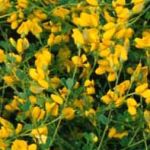| Common Name: |
Indigoweed |
| Other Names: |
Wild Indigo, rattleweed |
| Botanical Name: |
Baptisia tinctoria |
| Genus: |
Baptisia |
| Family: |
Papilionaceae |
| Native Location: |
Eastern N America |
| Cultivation: |
Well-drained, sandy soil in sun. Large roots resent disturbance. |
| Propagation: |
By seed sown when ripe; by division in early spring. |
| Harvest: |
Roots are lifted in autumn and dried for use in decoctions, liquid extracts, and tinctures. They can be kept for up to two years. |
| Height: |
1.2m (4ft) |
| Width: |
60cm (24in) |
| Hardiness: |
Z5-9 |
| Parts Used: |
RootsS |
| Properties: |
An acrid, bitter, antiseptic herb that stimulates the immune system and is particularly effective against bacterial infections. It also lowers fever and has laxative and emetic effects. |
| Medicinal Uses: |
Internally for tonsilitis, pharyngitis, and upper respiratory tract infections; excess causes nausea and vomiting. Externally for boils, ulcers, gum disease, sore nipples, and vaginitis. Regarded in Ayurvedic medicine as a cooling alterative, which can have deleterious effect if take for too long or in excess. Combines well with Capsicum frutescens (see tabasco pepper), Commiphora myrrh (see myrrh), and Echinacea purpurea (see echinacea) for throat infections; with Arctium lappa (see burdock), Phytolacca americana (see Indian poke), and Viola odorata (see violet) for boils and swollen lymph glands; and with Cephaelis ipecacuanha (see ipecac) for aphthous ulcer. Used in homeopathy for influenza and sore throat associated with nervous exhaustion. |
| Bibliography: |
Encylopedia of Herbs by Deni Brown Copyright ©: 1995, 2001 Dorling Kindersley Limited pp 140-141
|

